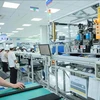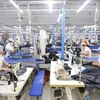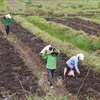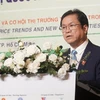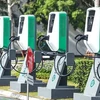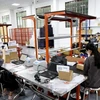More and more domestic pharmaceutical firms have recently announced plans to expand their production as the market has shown signs of picking up in recent months, an English language news website reported.
According to the VietNamNet Bridge, in Vietnam, there are 178 pharmaceutical manufacturers, including 100 western medicine and 78 oriental medicine enterprises, about 300 oriental medicine manufacturers, and numerous distributors of imported drugs.
Although Vietnam inherited Eastern traditional medicine from their ancestors, the country can now produce only 50 percent of domestic demand.
The limited domestic production capability, plus increasingly high demand for healthcare services and drugs, can explain why the Vietnamese drug market has always been very attractive.
The latest report of the Business Monitor Index, a market survey firm, showed that drug consumption maintained an impressive high growth rate of 16 percent last year.
However, with market value estimated at 3.3 billion USD last year, Vietnamese have only spent 2 percent of GDP on medicine, a very modest figure.
By the end of 2013, every Vietnamese spent 35 USD a year on drugs on average, a very low level if compared with regional countries such as Malaysia, Thailand (70 USD per annum) or Singapore (150 USD).
The figures give investors more reason to hope that they will have great opportunities to do business in Vietnam, as Vietnamese incomes and expenditures are increasing rapidly.
GlobaData, a global pharmaceutical market survey firm, in its report released in June 2014, also commented that the Vietnamese drug market was very promising.
The firm predicted that the Vietnamese pharmaceutical market value would reach 8 billion USD in the next six years.
The Government, in its pharmaceutical industry development strategy by 2020, stated that by that time, Vietnam-made products must satisfy 80 percent of market demand.
If this happened, Vietnamese pharmaceutical companies would be able to get eight to 10 pieces of the cake, or they would pocket 6.4 billion USD.
Vietnamese players
Hau Giang Pharmacy, the Vietnamese biggest pharmaceutical firm in Vietnam, last November completed the construction of a new factory which would help increase the output by twofold to 9 billion units per annum.
Meanwhile, Imexpharm, which is believed to have the most advanced production lines, has also finished the construction of a factory specializing in making penicillin injections in Binh Duong province.
While Hau Giang Pharmacy is dominating the southern market, the northern market is being dominated by Traphaco.
While the former focuses on making popular products antibiotics, analgesics and respiratory drugs, the latter makes functional foods with natural materials.
Planning to buy medical equipment companies in some key provinces such as Thai Nguyen in the north, Dak Lak in the Central Highlands and Quang Tri in the central region, Traphaco is making hectic preparations to set up a large distribution network for its products throughout the country.-VNA
According to the VietNamNet Bridge, in Vietnam, there are 178 pharmaceutical manufacturers, including 100 western medicine and 78 oriental medicine enterprises, about 300 oriental medicine manufacturers, and numerous distributors of imported drugs.
Although Vietnam inherited Eastern traditional medicine from their ancestors, the country can now produce only 50 percent of domestic demand.
The limited domestic production capability, plus increasingly high demand for healthcare services and drugs, can explain why the Vietnamese drug market has always been very attractive.
The latest report of the Business Monitor Index, a market survey firm, showed that drug consumption maintained an impressive high growth rate of 16 percent last year.
However, with market value estimated at 3.3 billion USD last year, Vietnamese have only spent 2 percent of GDP on medicine, a very modest figure.
By the end of 2013, every Vietnamese spent 35 USD a year on drugs on average, a very low level if compared with regional countries such as Malaysia, Thailand (70 USD per annum) or Singapore (150 USD).
The figures give investors more reason to hope that they will have great opportunities to do business in Vietnam, as Vietnamese incomes and expenditures are increasing rapidly.
GlobaData, a global pharmaceutical market survey firm, in its report released in June 2014, also commented that the Vietnamese drug market was very promising.
The firm predicted that the Vietnamese pharmaceutical market value would reach 8 billion USD in the next six years.
The Government, in its pharmaceutical industry development strategy by 2020, stated that by that time, Vietnam-made products must satisfy 80 percent of market demand.
If this happened, Vietnamese pharmaceutical companies would be able to get eight to 10 pieces of the cake, or they would pocket 6.4 billion USD.
Vietnamese players
Hau Giang Pharmacy, the Vietnamese biggest pharmaceutical firm in Vietnam, last November completed the construction of a new factory which would help increase the output by twofold to 9 billion units per annum.
Meanwhile, Imexpharm, which is believed to have the most advanced production lines, has also finished the construction of a factory specializing in making penicillin injections in Binh Duong province.
While Hau Giang Pharmacy is dominating the southern market, the northern market is being dominated by Traphaco.
While the former focuses on making popular products antibiotics, analgesics and respiratory drugs, the latter makes functional foods with natural materials.
Planning to buy medical equipment companies in some key provinces such as Thai Nguyen in the north, Dak Lak in the Central Highlands and Quang Tri in the central region, Traphaco is making hectic preparations to set up a large distribution network for its products throughout the country.-VNA

